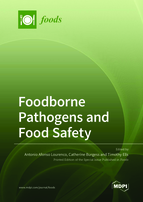Foodborne Pathogens and Food Safety
A special issue of Foods (ISSN 2304-8158). This special issue belongs to the section "Food Quality and Safety".
Deadline for manuscript submissions: closed (10 February 2022) | Viewed by 88471
Special Issue Editors
Interests: assessment of the microbiological diversity in biofilms associated with the dairy industry; transcriptomics of food-associated microorganisms; modeling the behavior of foodborne pathogens under environmental stress conditions such as low water activity
Interests: pathogens; antimicrobial resistance; escherichia coli foodborne diseases; salmonella
Special Issues, Collections and Topics in MDPI journals
Interests: Interactions of bacterial foodborne pathogens with commensal constituents in multi-species biofilm communities. Stress adaptations of foodborne pathogens in response to inimical conditions along the food continuum.
Special Issue Information
Foodborne pathogens represent a major burden on society as they are the cause of high numbers of illnesses, hospitalizations, and deaths each year. In addition to their detrimental impact on human health, these microorganisms, which include pathogenic bacteria, viruses, fungi, and a range of parasites, also represent a significant economic cost to food companies in the implementation and constant oversight of food hygiene and safety programs, product recalls, and potential litigation if outbreaks occur. Advancing our current knowledge of the food processing chain and its vulnerabilities to the many factors related to foodborne pathogens (e.g., their stress response, survival and persistence in processing environments, acquisition of virulence factors and antimicrobial drug resistance) is paramount to the development of effective strategies for early detection and control of pathogens, thereby improving food safety.
This Special Issue welcomes original research articles contributing to a better understanding of the impact of all aspects of foodborne pathogens on food safety. Papers on the following topics are particularly encouraged:
- Physiology, genetics, biochemistry, and behavior of foodborne pathogens;
- Effects of antimicrobials and packaging systems on foodborne pathogens;
- Predictive microbiology applied to foodborne pathogens in foods;
- Interactions of pathogens in microbial communities and the ecology of foods, food production, and food processing environments;
- Improved or novel methods for the detection, identification and enumeration of foodborne pathogens and microbial toxins;
- Microbiological challenge testing for ensuring the safety of food products;
- Risk assessment and microbial responses to stresses in the food chain.
Dr. Antonio Afonso Lourenco
Dr. Catherine Burgess
Dr. Timothy Ells
Guest Editors
Manuscript Submission Information
Manuscripts should be submitted online at www.mdpi.com by registering and logging in to this website. Once you are registered, click here to go to the submission form. Manuscripts can be submitted until the deadline. All submissions that pass pre-check are peer-reviewed. Accepted papers will be published continuously in the journal (as soon as accepted) and will be listed together on the special issue website. Research articles, review articles as well as short communications are invited. For planned papers, a title and short abstract (about 100 words) can be sent to the Editorial Office for announcement on this website.
Submitted manuscripts should not have been published previously, nor be under consideration for publication elsewhere (except conference proceedings papers). All manuscripts are thoroughly refereed through a single-blind peer-review process. A guide for authors and other relevant information for submission of manuscripts is available on the Instructions for Authors page. Foods is an international peer-reviewed open access semimonthly journal published by MDPI.
Please visit the Instructions for Authors page before submitting a manuscript. The Article Processing Charge (APC) for publication in this open access journal is 2900 CHF (Swiss Francs). Submitted papers should be well formatted and use good English. Authors may use MDPI's English editing service prior to publication or during author revisions.
Keywords
- foodborne pathogens
- antimicrobial susceptibility
- virulence
- foodborne illnesses
- food safety
- food contamination
- modeling
- risk assessment
- food chain







